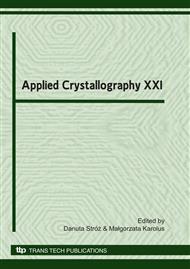p.84
p.88
p.93
p.97
p.101
p.106
p.110
p.114
p.118
Structure and Properties of the Melt-Spun Fe41Ni39P10Si5B5 Alloy Heat Treated at Elevated Temperatures
Abstract:
The aim of the work was to provide information on structure development and change of properties at elevated temperatures in Fe41Ni39P10Si5B5 amorphous alloy. The alloy was characterized by X-ray diffraction. The changes of properties were characterized with use of dynamic mechanical thermal analysis (DMTA) and the resistivity measurements at elevated temperatures. The microstructure of the melt spun ribbon was investigated with use of transmission electron microscope (TEM) at different stages of phase transformations after heating to different temperatures. The initially amorphous structure undergoes phase transformations due to glass transition and crystallization of the alloy. The appearance of glass transition region results in decrease of storage modulus and in a reversible change of temperature coefficient of resistivity (TCR). The phases are characterized with use of TEM. The crystallization was found to have the two stages. Formation of bcc crystals and Ni12P5 is followed by transformation of the products into fcc crystals and Ni3P. Temporary changes of the storage modulus and elongation of the sample suggest formation of hard phases during crystallization.
Info:
Periodical:
Pages:
101-105
Citation:
Online since:
June 2010
Authors:
Price:
Сopyright:
© 2010 Trans Tech Publications Ltd. All Rights Reserved
Share:
Citation:


